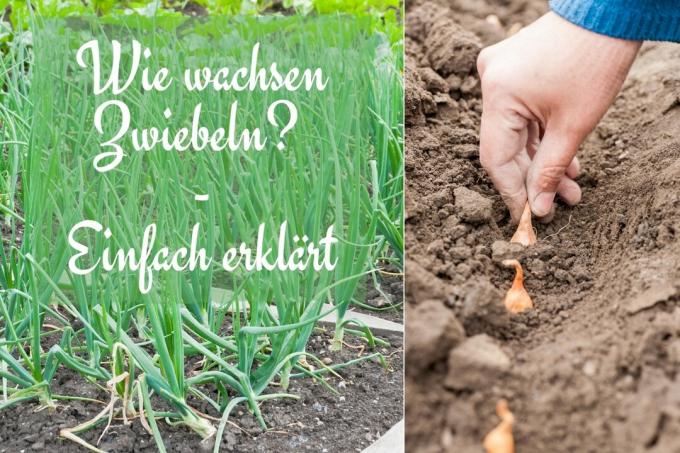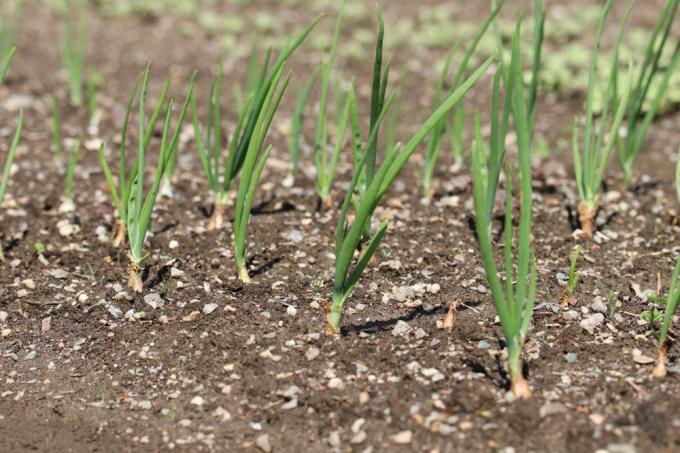
table of contents
- The site
- The floor
- The sowing
- Distance and height
- Sowing as an alternative
- The care
- The harvest
- frequently asked Questions
Onions are one of the most popular and widespread vegetables. If you know how best to grow them, you can look forward to an abundant harvest.
In a nutshell
- The planting can take place every two years as a seed, or one year as an onion set
- If the soil is suitable, the onion is very undemanding
- When planting in spring, watering can usually be completely dispensed with
The site
Since they can be planted early in the year, bulbs grow best in full sun, well protected. A light cold frame or the greenhouse are particularly suitable for the first planting. Later in the year, the plants thrive just as well outdoors in a sunny location.

The floor
Since the edible bulbs of the onions grow underground, the soil is of particular importance for the development of the plants. They thrive particularly well in soils with these properties:
- relaxed
- sandy-loamy
- high proportion of humus
- little stone fractions / solid or hard components
- not too damp
Tip: Even an unfavorable soil can be improved very well. Raise well-rotted compost under the ground before sowing. Alternatively, you can also use farmyard manure, which, however, should ideally be undermined before winter. So it can continue to rot until spring.
The sowing
Typical of the onion is the use of onion sets instead of growing from seeds. The onion sets already have a minimum size and the first roots. Therefore, they establish themselves particularly well at the chosen location and quickly take up the desired growth in size. The young cuttings can be planted from March, in the greenhouse or cold frame, if the weather is favorable, as early as the end of February.

Distance and height
Depending on the species, onions can reach heights of around 30 to over 50 centimeters. So that the individual plants do not interfere with each other, you should plant them as follows:
- Row spacing around 20 centimeters
- Plant spacing in the row about 10 centimeters
- Select the planting depth so that the tip of the bulb just looks out of the ground
- Water the plants lightly
Sowing as an alternative
Of course, you can also grow the onion sets yourself. To do this, proceed as follows:
- Sow outdoors from April
- Spread the seeds evenly
- Cover the seeds with a thin layer of compost and water
- No pricking or singling required
- Removal of the onion sets about the size of a hazelnut from August
- Store in a dark, dry and warm place until the following spring
- Use as described as onion sets
The care
Basically, onions are very easy to care for plants. In addition to a little water, if the soil is well prepared, it does not need any further support. In spring in particular, watering can be largely dispensed with, as the tubers can cope well with temporary drought. On the other hand, they do not like waterlogging, as the moisture can quickly lead to powdery mildew or rot.
The most common pests are the onion flies. But you can get through the Mixed culture keep away very well with the following plants:

- Carrots
- peppermint
- sage
The harvest
The tubers can be harvested as soon as they reach the desired size. Until then, onions will continue to grow and increase in volume. However, they should be taken out of the ground before flowering, as the nutrient stores are then used by the plant itself and the vegetables are only edible to a limited extent.
frequently asked Questions
Like most tubers, the onion tends to grow elongated if the soil is too loose. So give the soil some time to compact again after digging.
Primarily rotten onions if the humidity at the storage location is too high. Then putrefactive bacteria multiply very well. Make sure it is stored in a dry, well-ventilated place.
In the end, purchased onions save you time and effort. However, the plants themselves are usually identical to self-grown ones, so that no larger or higher quality tubers arise from them.
